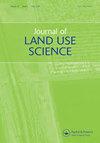Quantifying oil palm expansion in Southeast Asia from 2000 to 2015: A data fusion approach
IF 3.3
4区 环境科学与生态学
Q1 AGRICULTURE, MULTIDISCIPLINARY
引用次数: 1
Abstract
ABSTRACT The fusion of optical imagery with radar data can provide more accurate land cover change analysis of deforestation and tree-based agriculture. Radar data is limited temporally with most geographic areas not covered prior to 2007. This paper presents a new methodology to classify land cover change related to oil palm expansion that takes historic data limitations into account. Our approach utilizes Hansen’s Global Forest Cover data, optical imagery, and texture information, to extract land cover information in Sumatra and Western Malaysia, where historical data is absent. Our method demonstrates how to accurately classify oil palm without radar data with overall accuracies for optical only experiments within 4.4% of optical plus radar classifications. Our results show agricultural land use was the primary driver of land cover change with the largest increase due to oil palm expansion (6.1%). Better estimations of oil palm expansion could be used in sustainable land management policies.量化2000 - 2015年东南亚油棕扩张:数据融合方法
摘要光学图像与雷达数据的融合可以提供更准确的森林砍伐和树木农业的土地覆盖变化分析。雷达数据在时间上是有限的,大多数地理区域在2007年之前都没有覆盖。本文提出了一种新的方法来分类与油棕扩张相关的土地覆盖变化,该方法考虑了历史数据的局限性。我们的方法利用汉森的全球森林覆盖数据、光学图像和纹理信息,提取苏门答腊岛和马来西亚西部的土地覆盖信息,而这些地区缺乏历史数据。我们的方法演示了如何在没有雷达数据的情况下准确地对油棕进行分类,仅光学实验的总体准确率在光学加雷达分类的4.4%以内。我们的研究结果表明,农业土地利用是土地覆盖变化的主要驱动力,其中油棕扩张带来的增长最大(6.1%)。对油棕扩张的更好估计可以用于可持续土地管理政策。
本文章由计算机程序翻译,如有差异,请以英文原文为准。
求助全文
约1分钟内获得全文
求助全文
来源期刊

Journal of Land Use Science
Environmental Science-Management, Monitoring, Policy and Law
CiteScore
5.40
自引率
6.20%
发文量
26
期刊介绍:
The Journal of Land Use Science provides a central outlet for high-quality articles on theoretical and empirical aspects of land-use science at the interface of social and environmental systems. The Journal brings together an array of research perspectives at multiple temporal, spatial and social scales that contribute a better understanding of land-system dynamics and communicate scientific advances towards attaining land-system sustainability.
 求助内容:
求助内容: 应助结果提醒方式:
应助结果提醒方式:


